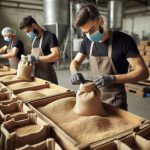This market in India has grown exponentially over the last ten years, through higher awareness and interest in consumer health-conscious practices, demand for organic, and natural ingredients. Its basis is very strong, anchored in traditional medicinal systems called Ayurveda, which underlines the possibility of herbs and plants being therapeutically healing. As the present-day beauty industry has seen the tide shifting towards sustainable and plant-based products, herbal cosmetics will find an upward curve in India. The causes behind increased demand for herbal cosmetics in India, processes for manufacture, raw materials adopted, quality control measures implemented, market size, and the challenges faced by the industry have been discussed here. This article has tried to analyse the rise in the demand for herbal cosmetics in India through the manufacturing process, use of raw materials, quality control measures, size of the market, and the challenges that face the industry.
Reasons for Rise in Demand for Herbal Cosmetics in India
This coincidence of cultural heritage, awareness of health concerns, and shift in the preference pattern of consumers has led to the increased demand for herbal cosmetics in India. The ever-increasing consciousness of synthetic chemicals’ impacts on human health has resulted in the majority of consumers seeking healthier and wellness-oriented alternatives such as herbal and organic products. This trend runs strong among the Millennials and Gen Z population, preferring sustainable, environment-friendly products and herbal cosmetics that fit their bill, which are not only plant-based but biodegradable too. Increased discretionary income has also upped their spending capacity, making the Indian middle-class consumer splurge on high-value, quality products, thereby demanding herbal cosmetics. Added by the strong cultural ties India has with Ayurveda, this trend is highly intensified as Ayurveda, in its holistic wellness approaches, is again of more interest not only in that country but also outside India borders. The endorsement of this product by celebrities and influencers as a healthy choice and in being trendy in modern lands of beauty has been significantly supportive.
India – A Land Rich in Ayurveda and Herbal Cultivation
The nation is also called the “Land of Ayurveda” in the context of the country’s long history of the use of herbs with health and beauty benefits. The varied climate across the country ensures the growth of a wide number of herbs and medicinal plants, which are excessively used in herbal cosmetics. Kerala, Himachal Pradesh, and Uttarakhand are especially known for natural herb cultivation. Since the tropical climate and large agricultural land, coupled with the information about ancient forms of cultivation, made India an important player in herbal cultivation.
Ayurvedic texts have been a great record of many plants like neem, aloe vera, turmeric, and ashwagandha that are used extensively in herbal cosmetics. Much thrust on Ayurvedic principles generally has transformed the demand for cosmetics to be not only functional but also safe for longer usage.
How Are Herbal Cosmetics Manufactured in India?
Indian manufacturers are a balancing act of the old knowledge of Ayurvedic practice and new scientific research that will give much more effective quality results for producing their herbal cosmetics. Pure materials at this very primary level are derived from the countryside with high reputations in organically cultivated, pesticide- and chemical-free land to assure purity: a passport for knowing the grade quality. Techniques to get out the active principles differ-such as cold pressing in obtaining essential oils or, like steam distillation to have floral waters, etc. These extracts are then mixed and processed into creams, shampoos, among others according to Ayurveda. This process will see different mixes being formulated according to the different types of dosha so as to realize maximum benefits. Product safety, stability, and effectiveness are assured by the thorough testing and quality control of these products. The products are packed in biodegradable materials with labels that feature the beauty of natural chemical-free products since the public requires sustainability and transparency.
Raw Materials Used in Herbal Cosmetic Manufacturing
Indian herbal cosmetics use strong natural ingredients. Each ingredient provides some unique benefits that add zing to your skincare and haircare routine. Most moisturisers and soothing gels use aloe vera. It is famous for hydrating and healing properties. Neem is used in facewashes, hair oil, soap, creams and moisturizers for keeping the skin free from bacterial, and germs. Ashwagandha is known to rejuvenate and finds its place in all anti-aging products. Sandalwood with its refreshing smell and cooling sensation is always in high demand in face packs and natural perfumes. Finally, essential oils like tea tree, lavender, and eucalyptus provide a medicinal value-added fragrance and efficiency to the herbal products thus creating a holistic solution for beauty care.
Quality Control Measures for Herbal Manufacturers and Suppliers
Quality and safety are the most emphasized criteria when it comes to herbal cosmetics, as they will always come into contact with human skin. Every batch of material received is tested in terms of purity, extent of contamination, and strength in order to ensure that only safe and potent components are put together in the production of that product. Microbial tests will determine the level of harmful bacteria or fungi present, which may cause an infection or allergies on the skin. The heavy metal test is another critical test as these metals absorbed, for instance lead or mercury through skin could cause medical disorders, the pH test confirms if the products are formed which is safe on skin are non-breaching agents not so irritating easily to skin stability which is the shelf-life testing under tests of whether this stability persists in, heat as well as in wet. Indian herbal cosmetics maintain such levels of quality by following the rules set by Central Drugs Standard Control Organisation and Ministry of AYUSH, wherein organizations promise the product’s safety and authentication.
Market Size of Herbal Cosmetic Products in India
The herbal cosmetics India market has been quite active with a projected market size crossing over $1 billion in the next few years. In the herbal cosmetic segment, it has reportedly grown at around 15-20% annum which has gone ahead of the general beauty and personal care market. The growth of this market is mainly attributed to urbanization, growing disposable income, and the popularity of Ayurveda among both urban and rural consumers.
International players entering the Indian market and the dispersal of Indian brands across other nations, the herbal cosmetics segment will grow. Some names of the brands that have been advertising herbal products both in India and in the global market include Himalaya, Forest Essentials, Patanjali, Boutique, and Kama Ayurveda.
Problems of the Indian Herbal Cosmetics Industry
High growth notwithstanding, major challenges remain with standardization of herbal cosmetics. Here, inconsistencies in sourcing raw materials, processing, and authenticity of ingredients cause the quality of products to vary and is perceived in consumer trust. Moreover, synthetic products remain predominant in the market as they are relatively more affordable and accessible, thus stiff competition for herbal options. This is expensive for the manufacturer, raising the production prices and making herbal cosmetics far less available to most women. Complying with regulations is one more headache, especially from smaller manufacturers who have hard times dealing with strict norms. The increase in bogus products also lowers the validity of a brand and further puts consumer health and the general reputation of the brand under threat. The market is still characterized by a low level of awareness among consumers on the benefits of herbal cosmetics; education is thus necessary to build consumer confidence and scale up the market.
Conclusion
This coming together of tradition and innovation makes the herbal cosmetic market of India an exciting place for modern consumer requirements, such as safe, natural, and eco-friendly beauty solutions. From high-quality raw material sourcing to strict quality control standards, the industry is emerging to meet both domestic and global demand. Standardization, competition, and a host of other problems and issues won’t go away for India’s herbal cosmetics market, but consumers interested in holistic wellness and sustainability will continue to take this market to new heights.
As India unlocks its rich Ayurvedic heritage and full agricultural potential, herbal cosmetics will explode into a global leader in the natural beauty market, focusing on products that are deeply rooted in tradition but maintain the latest trends of beauty.



